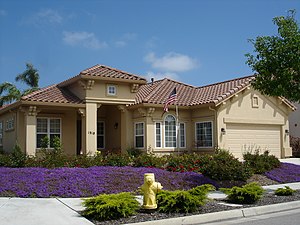
A house is a building that is made for people to live in. It is usually built for a family (parents and their children).[1] It is a "permanent" building that is meant to stay standing. It is not easily packed up and carried away like a tent, or moved like a caravan. If people live in the same house for more than a short stay, then they call it their "home". Being without a home is called homelessness. Houses are usually numbered. Some are also named.
Houses are usually occupied by a single family or housemates, like in the cases of group homes and boarding houses.
Houses come in many different shapes and sizes. They may be as small as just one room, or they may have hundreds of rooms. They also are made many different shapes, and may have just one level or several different levels. A house is sometimes joined to other houses at the sides to make a "terrace" or "row house" (a connected row of houses).
A big building with many levels and apartments is called "a block of flats" (British) or an apartment building. One of the differences between a house and an apartment is that a house has a front door to the outside world, whereas the main door of an apartment usually opens onto a passage or landing that can be used by other people in the building.
Houses have a roof to keep off the rain and sun, and walls to keep out the wind and cold. They have window openings to let in light, and a floor. Houses of different places may look different to each other, because of different materials, climate, and styles.
If a house is important and historic enough, it can be a museum showcasing how the house's residents lived.
Types
[change | change source]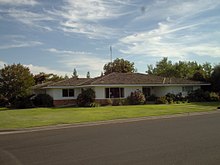
Most houses have special areas or rooms for people to do the things that they need to live comfortably. A modern house has a place to cook food, a place to eat, places to sleep and a place to wash. These things are usually done in separate rooms, which are called the kitchen, the sitting room, the bedrooms, the bathroom, the toilet (or lavatory). Many houses have a separate dining room for eating meals and a separate laundry. In some houses the toilet is in the bathroom, and in other houses it is separate. Many houses may also have a "study" or computer room and a "family room" where the children can play games and watch television.

Detached house
[change | change source]In some countries such as the United States, Canada, Australia and New Zealand many families live in a "detached house" which is separate from other buildings and surrounded by its own yard, but is close enough to town to have shops, good transport and entertainment nearby. In many other countries, including most of Europe, owning a house like this is something that only the richer families can afford, and is just a dream for most people.

Houses in very poor places
[change | change source]In many very poor countries, a lot of people live crowded in houses with only one room. They often have to share a toilet with many other families, and have to do the cooking outside. The house might be made of materials that can be found nearby like mud bricks and grass or from second-hand materials like corrugated iron and cardboard boxes. In many cities there are thousands of small houses crowded together with narrow alleys between them.

Cottage
[change | change source]A small house is often called a cottage. In England, where this word comes from, it is used to mean a house that has one main storey, with a second, lower storey of bedrooms which fit under the roof upstairs. Cottages are usually found in villages or in the countryside. They are nearly always built from material that can be found nearby. In many places the word cottage is used to mean a small old-fashioned house. In the United States the word cottage is often used to mean a small holiday home.
Tiny
[change | change source]A tiny house is one that's usually 500sqft / 48sqm in size and typically built on a trailer or barge and thus portable. Tiny houses can also be built on smaller versions of conventional foundations.
Semi-detached or duplex
[change | change source]
A semi-detached house is a building that has two houses side by side and covered over by just one big roof. Each house has a pathway to one side, leading from the front to the backyard. Semi-detached houses are very common in some cities, and can be single storey or several storeys high.
Terraced houses
[change | change source]A row or terraced house is a house that is part of a row of houses joined at the side walls. Many cities and towns have thousands of row houses because they are a good way to build several houses close together. Many row houses have two rooms downstairs and two rooms upstairs, with a kitchen or wash area at the back. Houses like this were built for poor factory workers and coal miners in many cities and towns. "Terrace houses" are a type of row house where each house has a similar front to its neighbours.
Row houses are not always small. Some cities have large beautiful row houses, such as the Royal Crescent, which was built in the 1770s at Bath in England and is a famous example of Georgian architecture.
Bungalow
[change | change source]
In some places, the word "bungalow" is used for any house that is all on one level. The word came from India and for a long time was used for a house that is built all or mostly on one level (though it can have an attic and or basement) and has a verandah where people can sit or work outdoors, but under a shady roof. A bungalow often has a hall down the middle of the house to let the breeze blow through. Bungalows are often seen in countries with hot summers, in India, South East Asia, South Africa, parts of the United States, South America, Australia and New Zealand. In regions with flooding, a bungalow is often built up on wooden "stilts" or a high basement. In the 1800s, bungalows were nearly always built of wood, but from the 1920s it became fashionable to build them of brick as well.

Farmhouse
[change | change source]A farmhouse may look like a cottage, a bungalow or a mansion. In many countries a farmhouse can look different to a house in a town. As well as having a place for people to live, it also has a place for animals.
Three typical types of farmhouses are found. Many farm houses are long and have two doors. One door leads to the rooms used by the family. The other door opens into a stable for the cows, sheep and chickens. The stable part often has a loft where hay can be kept to feed the animals in the winter. Another type of farmhouse has two storeys with a big stable and storeroom underneath, with the rooms for the family on the upper floor. Another type of farmhouse has buildings such as the family house, the barn and the stable all joined around a central courtyard. Old farmhouses of these three types can be found in many parts of Europe and Great Britain.
Mansion
[change | change source]
A mansion is a big grand house, usually with two stories and sometimes more. A mansion often has beautiful architecture, and shows that the person for whom it was designed and built was rich. Mansions often have beautiful gardens. Sometimes a mansion does not belong to a private family, but to a town council, to a big business company, to a church or college and is an official residence for a person with an important job to live and to entertain guests.
A mansion often has rooms which are not found in ordinary houses, such as a drawing room, a ballroom, a library and a music room. Mansions often need servants to help keep them in order and have servants' quarters and special rooms where the servants do particular jobs such as cleaning. Well-known mansions are the White House in Washington, D.C. where the President of the United States lives and Mansion House in London where the Lord Mayor of London lives.

Castle
[change | change source]A castle is a fortified house constructed in the medieval period, or a house constructed to look like a medieval fortification. Castles protected feudal lords from their attacking enemies. In later periods, castles were built as part of romanticist revival movements of the 19th and early 20th centuries.
Palace
[change | change source]A palace is a house that is very grand for people like Kings and Queens, or other rich people. Many palaces are homes of royal or aristocratic people. Some old palaces been changed by people who lived there over many hundreds of years.
One of the best-known palaces in the world is Buckingham Palace, a royal palace in London. The largest palace in the world is the Louvre which was built in Paris for the Kings of France. It now holds a famous art gallery.
Building materials
[change | change source]Houses are usually built from types of material that can easily be made or bought near the place where the house is built. Because of this, old houses in different towns and different villages look quite different to each other, even in the same country. In modern times building materials can be transported easily and this means that a builder can choose materials from far away.
Mud and clay
[change | change source]
In many parts of the world, mud or clay are the main building materials. Clay is a type of soil that sticks together more strongly than most other types of soil. There are three main ways of building walls with mud and clay.
- One way to make a house of clay is simply to pile up the mud or wet clay with the hands, and flatten it into a wall shape. Often animal hair, straw and dung is mixed with the mud so that the fibres (stringy bits) help hold it together. Some wooden beams and thin wooden slats are used to hold the roof, which is also made of mud or clay. The roof is flat and strong enough to walk on, but must slope a bit, in case of rain. The walls are often protected from rain with plaster and paint. In many countries the walls are usually white, but in other places all the houses are painted different bright clolours. These types of houses are only found in very dry countries. Houses built in this way give good protection against the very hot sun and hot dry winds of the dessert. In the cold nights they stay quite warm.
- A second way to make the walls of a house out of mud of clay is "wattle and daub". "Wattle" is weaving from sticks. First, long sticks are stuck into the ground and then very thin sticks are woven through them, like making a basket. The thin wattle wall is then "daubed" or stuck all over on the inside and the outside with damp clay, mud or plaster, usually with some chopped straw or animal hair to help it stick together. "Wattle and daub" are often found in quite damp places where bendy willow trees or acacias (also called "wattle trees") grow. The walls need good protection from the rain, so houses like this often have roofs that have big "eaves"; the roof sticks out all around the house so that the water does not run down the walls. "Wattle and daub" houses often have big roofs made of straw, reeds, banana leaves, palm leaves, wooden shingles or big sheets of bark.
- A third way to make a house of mud or clay is to shape the wet soil into bricks before building the walls. The bricks can be shaped by hand, but more often they are shaped in boxes or "moulds" so that all the bricks are just the same size and shape. They are left in the hot sun until they have dried hard. Then walls can be made which are the same thickness all the way up. Clay bricks that are dried in the sun were used in Egypt and Mesopotamia for thousands of years.
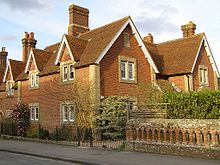
Fired bricks
[change | change source]It was discovered that if clay was used, rather than mud, very strong bricks could be made by "firing" (or baking) them in a "kiln" (a special oven). "Fired" bricks were like pottery; they did not wash away easily in rain and would sometimes last for thousands of years. The bricks were joined to each other with a type of cement called "mortar". Some houses built by the Ancient Romans are still standing 2000 years later.
Bricks became one of the most common building materials. In most cities, nearly all the houses are built of bricks because they are long lasting, they do not need repairing very often. Brick houses are generally made strong by having all the main walls two bricks thick. Two walls are built side by side which are "bonded" (or joined to each other) by having some bricks set so they make a bridge between the two layers. The pattern of the bonded bricks can be seen from the outside. The two main patterns are called "Flemish Bond" and "British Bond".

- Because brick walls are heavy, a brick house needs to have a very firm base or "foundation" to sit on. This often means digging deep into the ground to lay a foundation before a brick house can be built.
- Houses with brick walls often have tiled roofs, because the tiles can often be made at the brick factory.
- Modern bricks and tiles come in a big range of colours, because different materials can be transported from different areas. People who are employing a builder to build a home are nowadays often shown pictures of all the colours of bricks and tiles that are available. This means that although in old towns, every house is made of the same type of bricks, in a modern suburb every house may look quite different. The bricks range from white through shades of red, yellow and brown and are sometimes very patterned, while the roof tiles include blue, green and yellow as well as the traditional red, orange and brown.
- In some countries, the clay for bricks does not set very hard, and washes away more easily. If the bricks are not very hard, then it is usual to cover them with plaster or cement, which can then be painted. In other places, brick walls are not very fashionable so the walls are plastered and made more elegant with decoration. Plastering or cementing over brickwork is called "render" or "stucco". In many countries such as Austria, Italy and Spain, the brick houses are usually covered with stucco and are often painted cream, yellow, orange, pink, red or "orchre" (which is a mustard colour).

Timber
[change | change source]Houses made of timber are found wherever there are, or there has once been big forests. Timber houses are also often found in seaside towns where the sea air makes brick and stone houses feel cold and damp.
- One of the oldest ways to make a timber house is to cut tree-trunks into logs. The logs are then split in half so that there is a flat side for the inside of the wall and a round side for the outside. The logs then have big "notches' or holes cut into the ends, so that when they are piled up, the logs lock together at the corners of the building without any nails. These log cabins can be seen in Canada, in Switzerland, in Scandinavia, in Eastern Europe and in Japan.
- Many houses are made with a wooden "frame" or skeleton. On the outside of the frame, to keep out the weather, rows of flat boards are nailed, which overlap each other so that the rain cannot come in. Walls like this are called "clapboard" or "weatherboard". Clapboard houses are generally painted to preserve the timber. In England and some parts of the United States, they are nearly always painted white. In Australia where "weatherboard" houses are very common, they are usually painted in bright colours. In England and Australia, clapboard houses are usually quite small, but in the United States there are very many grand mansions that are built in this way.
- Some houses with a wooden frame have a brick wall on the outside and a wall of plastered board on the inside. This is called "brick veneer".

Half-timbered houses
[change | change source]A well-known type of old-fashioned house is the "half-timbered" house. These are seen in the British Isles, France, and across northern Europe and the Alps. These houses date mainly from about 1200 to about 1800.
- Half-timbered houses have a wooden frame built up of lots of thick timber pieces that are generally quite short. The timbers are arranged in a pattern with lots of diagonal pieces to act as braces. The strong wooden frame is then filled in with all sorts of other material. In some houses the "infil" is mainly of brick. In other houses, "wattle and daub" is used between the timber. Other houses have infill of "rubble" (rough stones) in clay or mud. The "infil is generally plastered over and painted white (or in some places a colour) while the timbers are often stained black. If they are not stained, they turn pale silvery grey. Hundreds of these houses exist, including some that are quite grand. In the 1800s and early 1900s, there was a fashion to copy "half-timbering" on modern brick houses.
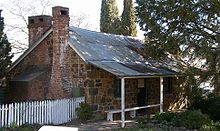
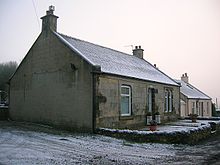
Stone houses
[change | change source]In places where there is lots of stone, many houses are built of it. In many parts of the world, little cottages are built of stone. Many mansions and palaces are also built of stone, as are nearly all castles.
- Some of the oldest houses in the world are made of stone, because stone lasts a long time. They are circular houses with walls of flat stone slabs laid carefully on each other. The walls sloped gently inwards to meet in a stone roof. Other prehistoric stone houses had roofs of thatch.
- In parts of the world where there is stone that can be broken into flat slabs, then walls can be built up without any "mortar" to join the stones together. But the wind blows through the gaps, so the walls need timber or render on the inside, to keep out the weather. Stone houses of this type often have roofs made of flat stones as well. Stone roofs are very heavy and are laid on very thick beams.
- Many stone cottages are built of flint or "rubble" or "cobble". These are broken stones that are brought from nearby hills, or stones picked up from the farmer's fields, or gathered from a river bed. The walls are built up with stones and mortar. In some places where flint is used, the hard stones are split or "knapped" so that when they are placed on the outside of the wall, they show a shiny flat surface which is more attractive than the dull lumpy outside of a flintstone.
- Some types of stone, particularly limestone and sandstone, can easily be cut into big blocks that can be built up like bricks. It can also be "dressed" or smoothed on its surfaces. In villages that are near a limestone or sandstone quarry where the stone is cut, many of the cottages are built of neatly cut stones. But in towns that are far away from the quarries, it is only the mansions and palaces that are built of stone, because it is very heavy and expensive to carry across the country.
- The good thing about the types of stone that are used for grand houses is that they can easily be carved into decoration. Grand houses often have decorative carvings around the doors and windows. The building stones may also have special textures at the basement or the corners of the building.
- Grand stone houses often have roofs of thin stone called slate. They also have roofs of expensive materials like copper and lead.
Making modern houses
[change | change source]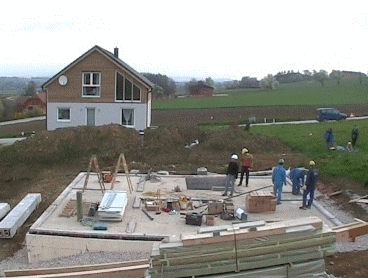
Modern houses are often made of "pre-fabricated" parts that are partly built in a factory, and are easy to put together at the site of the building. Many different types of materials for making houses have been developed in the 20th century.
- Many houses are now made with steel frames put together with rivets and bolts.
- Walls and roofs can be made of boards that combine fibre with cement. These boards are thin, light in weight to transport, easy to put on the frame, and much cheaper than bricks or timber. A similar material can be made into roof tiles.
- Metal roofing can be rolled into thin sheets, and made in many different colours, with matching gutters and downpipes.
Notes and references
[change | change source]- Nicholas Pevsner, An Outline of European Architecture, Pelican, ISBN
- Trewin Copplestone, Ed., World Architecture, Paul Hamlyn, ISBN
- John Summerson, Architecture in Britain, Pelican, ISBN 0140560033
- Trevor Yorke, Tracing the History of Villages, Countryside Books, ISBN 1-85306-712-1
- Richard Reid, The Book of Buildings, the Architecture of Europe and North America, Peerage Books, ISBN 0-907408-89-3
- R. Apperly, R. Irving and P.Reynolds, A Pictorial Guide to Identifying Australian Architecture, Angus and Robertson's, ISBN 0-207-16201-8
- W.R. Dalziel, All-Colour Guide to Architecture, Grosset and Dunlap, ISBN 0-448-00863-7
- ↑ Macmillan Dictionary for Students Macmillan, Pan Ltd. (1981), page 499. Retrieved 2010-7-23.